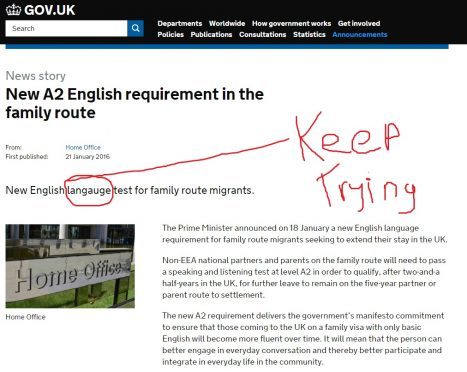The Prime Minister has announced a new English language requirement for family route migrants hoping to stay in the UK.
However David Cameron faces defending the competency of his government’s officials after a Home Office press release on English lessons for migrants misspelt the word “language”.
The PMs official spokesman said everyone is “open to mistakes”, adding that he is “fully confident” of his civil servants’ grasp of English.
The statement went on to describe how non-EEA national partners and parents “on the family route” will need to pass a speaking and listening test at level A2 in order to qualify, after two-and-a half-years in the UK, for further leave to remain on the five-year partner or parent route to settlement.
The new A2 requirement relates to the government’s manifesto commitment to ensure that those coming to the UK on a family visa with only basic English will become more fluent over time.
It will mean that the person can better engage in everyday conversation and thereby better participate and integrate in everyday life in the community.
The government recognises the need to give those affected sufficient time to prepare for the new test which is why the new requirement will not be implemented before October 2016. It will therefore not affect those required to apply for further leave to remain before then. The precise timing and further details will be confirmed by the Home Office in the next few weeks and published here on GOV.UK.
Since November 2010, non-EEA national partners of British citizens or persons settled in the UK applying for a visa or initial leave to remain under the family route have been required to demonstrate that they can speak and understand basic English.
This requirement was extended in July 2012 to parents of British citizens and persons settled in the UK.
Since October 2013, adult migrants applying for settlement (indefinite leave to remain) have been required to meet level B1 in speaking and listening skills and pass the new Life in the UK test.
The Prime Minister’s official spokesman said: “All of us are open to mistakes at times. The Prime Minister is fully confident that his team speak English competently. I’m sure there have been a few errors occasionally in newspapers, too.”
